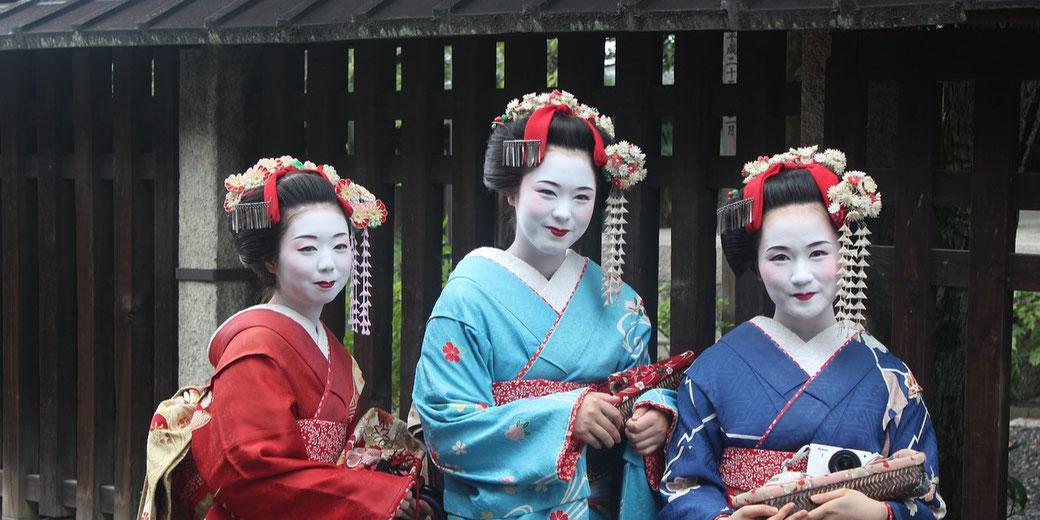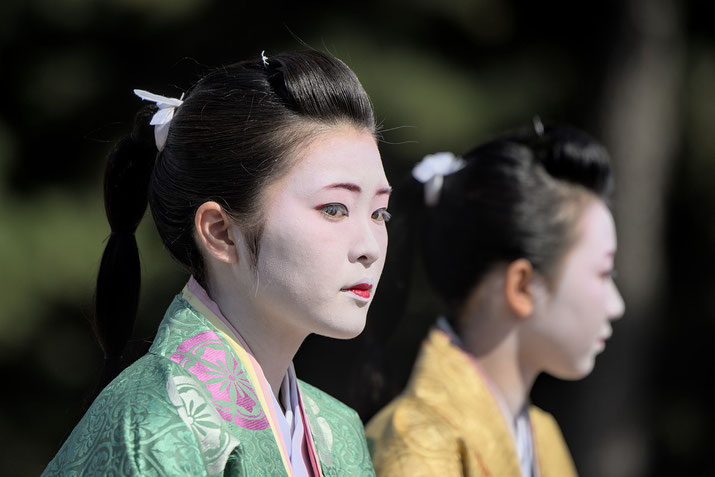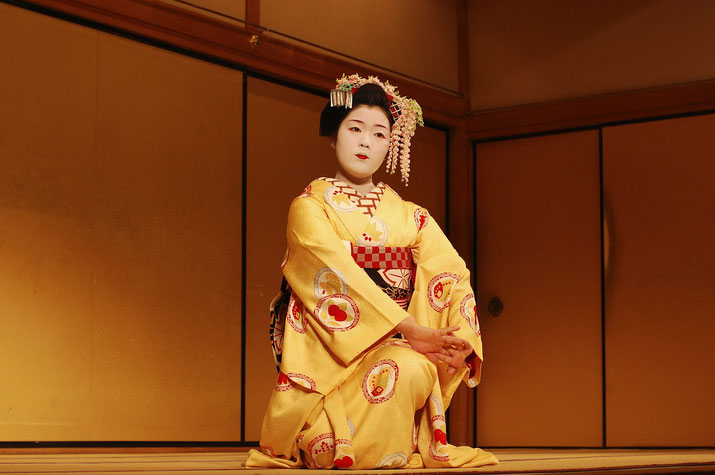The power and beauty of the Japanese Geisha

To encounter a geisha was to step into a world where every gesture and glance carried meaning. These women were celebrated for their elegance, yet their real strength lay in their command of performance and social interaction.
Through art and conversation, they created areas of influence in a society that rarely granted women public power.
The history of the Japanese Geisha
By the 7th century in Japan, women known as saburuko (“serving girls”) survived by either offering sexual services or entertaining at high-class gatherings.
Over time, as the imperial court settled in Heian-kyō (Kyoto) after 794, female performers such as the shirabyōshi dancers (court dancers) and later high-class courtesans (oiran) helped establish traditions of music and dance together with poetry as respected forms entertainments.
By the 17th century, Japan’s cities had separated pleasure quarters (yūkaku) where courtesans and prostitutes were licensed and ranked.
The oiran courtesans were the celebrities of their day, famous for expensive clothes, but their performances adhered to stiff aristocratic traditions that eventually grew old-fashioned.
Geisha as we know them first appeared around the mid-18th century as a smaller group within these pleasure quarters.
The earliest type of geisha were often men, sometimes called hōkan or taikomochi, who were hired to entertain customers waiting to see high-ranking courtesans, with music and comic storytelling.
Soon after, young female dancers and musicians (many originally teenage odoriko “dancing girls”) also began calling themselves geisha (“arts persons”) as they entertained guests with song and dance.
According to historical records, the first woman to publicly use the title of geisha was a talented shamisen player named Kikuya from Fukagawa around 1750.
Kikuya’s success as a performer (distinct from prostitution) launched a trend. Over the next decades, more women trained in the arts chose to become geisha instead of courtesans.
The profession had grown rapidly and was understood to be almost entirely female, established as an independent class of entertainer separate from prostitutes.
In 1779 the Tokugawa government passed a law formally differentiate geisha from courtesans: geisha were forbidden to sell sex and barred from wearing the gaudy hairstyles or kimono reserved for oiran, to protect the courtesans’ business.
Despite such regulations, geisha rose in popularity across social classes. Merchant townspeople, who lacked access to aristocratic courtesans, eagerly patronised machi-geisha (town geisha) for their lively entertainment and fashion sense.
By the 1830s, geisha had surpassed courtesans as trendsetters and style icons in Japanese society.
Women in cities copied geisha hairstyles and kimono, and geisha habits. For example, Tokyo’s Fukagawa geisha began the practice of women wearing the haori jacket, which became a widespread fashion trend.
Geisha were respected as artists first and foremost, adept at musical instruments like the shamisen lute and combining dance with poetic arts and witty conversation.
Some geisha still engaged in casual romances or had patrons, but a clear distinction was made: geisha were professional entertainers separate from courtesans; that fact is stressed to this day.

How did a person become a Geisha?
Young women traditionally entered the profession in their teens as apprentices (called maiko in Kyoto or hangyoku in Tokyo) and went through years of training in music, dance, etiquette, poetry, and the tea ceremony.
They lived in okiya, which are geisha houses run by experienced house managers (often called okāsan, “mother”), who managed their training and assignments.
Senior geisha guided the apprentices in a sort of “older sister” role to make sure that skills and customs passed from one person to another.
The okiya initially paid for the apprentice’s lessons, costumes, and living costs, which the geisha paid back after she began earning fees.
This system has historically created a close community within each hanamachi (geisha district), where everyone’s efforts maintained the reputation and quality of the art.
Importantly, a professional attitude is taught: geisha are expected to show artistic skill along with graceful behaviour and careful discretion, entertaining clients with grace.
They spoke and performed with charm rather than offering physical intimacy.
Strict rules and pride in their work helped geisha maintain dignity and earn respect in society.
The geisha community is sometimes called “the flower and willow world,” symbolising beauty (flower) and strength (willow).
Geisha are trained in several art forms, and they have preserved and spread traditional Japanese arts through many eras of change.
Their classical dances (such as the Kyoto-style Kyo-mai dance) and musical ensembles (shamisen, flute, drums) have been passed down continuously.
Many geisha are talented calligraphers, poets, and singers as well. The appeal of geisha also made them popular subjects in art and media.
Ukiyo-e woodblock artists frequently depicted elegant geisha in the pleasure quarters of Edo.
Later, with the arrival of photography and film, geisha appeared as symbols of Japanese beauty.
Their impressive range of skills
On the surface, geisha avoided open involvement in politics. They were entertainers and held no official political role.
Yet, the private setting of teahouses and banquets where geisha performed has historically been a social glue for the powerful.
In the Edo period, samurai officials and wealthy merchants could relax in geisha parlors, where strict hierarchies softened under the balm of music and sake accompanied by cultured conversation.
By the Meiji and Taishō eras, it was an open secret that crucial political discussions often took place in geisha districts.
In Tokyo, the nearness of Shinbashi geisha area to government offices meant it became an informal addition to the centres of power.
Politicians held meetings over dinner with geisha present to create a pleasant atmosphere.
In one remarkable example, the founding of Japan’s long-serving Liberal Democratic Party in 1955 reportedly arose from talks held at a traditional restaurant in the Kagurazaka geisha district.
The fact that modern Japan’s ruling party supposedly began in a geisha establishment showed how connected the geisha world was to political networking and deal-making.
Geisha provided a safe space for honest discussion among officials, away from prying eyes.
On occasion, individual geisha directly impacted politics. In the early 20th century, there was well-documented relationship between Prime Minister Katsura and a geisha named Okoi.
In other cases, geisha acted as trusted advisers or even mediators for statesmen.
During World War II, some geisha like Kiharu Nakamura used their positions to help their country and acted as informants or raised morale in subtle ways.

Modern Geisha
During the Meiji era (1868–1912), Japan underwent rapid change, and the geisha world adapted to new social rules.
The Meiji government ended the indentured servitude of geisha. It released young women from lifetime debts to their okiya (geisha houses) and introduced a licensing system that allowed any qualified woman to train and work as a geisha.
New geisha districts sprang up in cities beyond the old pleasure quarters. In Tokyo, districts like Shinbashi (near government offices) and Kagurazaka became especially important; Shinbashi geisha were supported by high-ranking government officials and even sometimes married them.
As Japan’s elite circles embraced Westernisation, geisha were caught in a discussion about culture.
Some modernizers viewed the geisha as remnants of an outdated, abusive past, while others saw them as skilled contributors to modern society.
Notably, geisha themselves took steps to maintain their position: house proprietors encouraged geisha to pursue education and stay informed on current affairs so they could keep up in conversation.
Geisha took part in patriotic and public activities. For example, geisha groups helped sew military uniforms during wartime and organized well-known charity drives for schools and shrines.
These efforts in the late 1800s briefly made geisha appear as examples of progressive womanhood.
However, by the turn of the 20th century, public opinion again shifted to see geisha as incompatible with new middle-class domestic ideals, and their image as only pleasure entertainers remained.
Geisha numbers and influence peaked in the early 20th century. During the 1920s and 1930s, being a geisha was a profitable and respected occupation.
Japan’s cities had tens of thousands of geisha. By the eve of World War II, there were as many as 80,000 active across the country.
The war years brought a sudden break: in March 1944, all geisha districts were ordered closed as the government redirected all available workers to the war effort, and most geisha were moved into factories or nursing roles.
After Japan’s defeat, the traditional geisha world tried to rebuild, but many former geisha did not return to the trade, and those who did found their reputation tarnished by people pretending to be geisha, impoverished women and some prostitutes who had begun calling themselves “geisha girls” to serve U.S. occupation troops.
This postwar confusion mixed up geisha with streetwalkers in the eyes of many Westerners, a misconception that true geisha had to work hard to dispel.
During the 1950s, the post-war boom saw business and political leaders once again host clients in geisha tea houses, and new apprentices were recruited to carry on the arts.
By the late 1950s, Tokyo’s Kagurazaka district alone had over 200 geisha serving at dozens of fancy restaurants.
In the decades since, the rise of other entertainment industries (bars, clubs, modern music and dance) and new labor laws (which mandate schooling and prohibit child apprenticeships) led to fewer young women entering the profession after the 1960s.
From a peak in mid-century, geisha numbers dwindled; by 1989 it was estimated that only about 1000 geisha remained nationwide.
In the main centre of Kyoto, the count of active geisha fell from hundreds in the 1960s to roughly 200 by the mid-2000s.
Some modern geisha still live in traditional okiya houses during their apprenticeship and must register with official groups. Others live at home and attend training part-time.
They entertain at private banquets in tea houses or expensive restaurants, and they charge fees for their time and skills as in olden days.
To adjust to new times, the geisha community has used new methods: some okiya run websites to recruit young women inspired by documentaries, and the internet now allows geisha to perform online for audiences around the world.
What do you need help with?
Download ready-to-use digital learning resources
Copyright © History Skills 2014-2025.
Contact via email
With the exception of links to external sites, some historical sources and extracts from specific publications, all content on this website is copyrighted by History Skills. This content may not be copied, republished or redistributed without written permission from the website creator. Please use the Contact page to obtain relevant permission.





